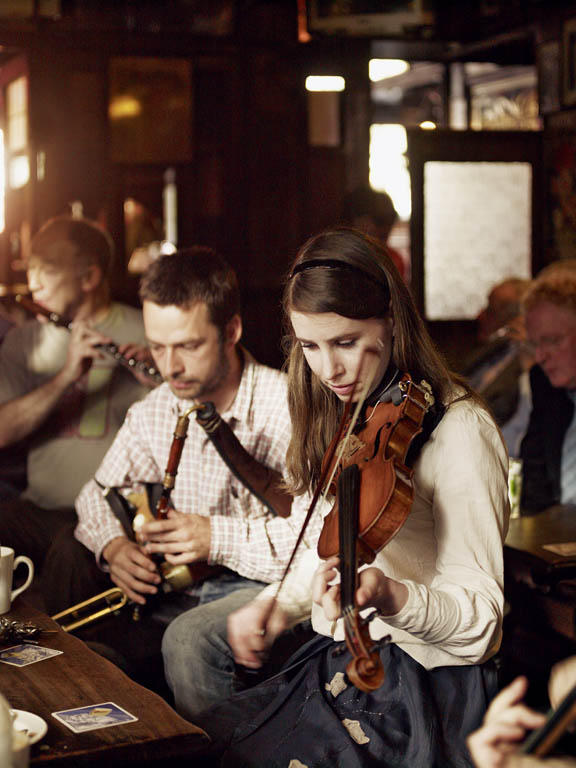Traditional Music
Irish music (known in Ireland as traditional music, or just trad) has retained a vibrancy not found in other traditional European forms, which have lost out to the overbearing influence of pop music. Although it has kept many of its traditional aspects, Irish music has itself influenced many forms of music, most notably American country music.

Instruments
Despite popular perception, the harp isn't widely used in traditional music (it is the national emblem, but that probably has more to do with the country traditionally being run by people pulling strings). The Bodhrán (bow-rawn) goat-skin drum is much more prevalent, although it makes for a lousy symbol. The uillean pipes, played by squeezing bellows under the elbow, provide another distinctive sound, although you're not likely to see them in a pub. The fiddle isn't unique to Ireland but it is one of the main instruments in the country's indigenous music, along with the flute, tin whistle, accordion and bouzouki (a version of the mandolin). Music fits into five main categories (jigs, reels, hornpipes, polkas and slow airs), while the old style of singing unaccompanied versions of traditional ballads and airs is called sean-nós.

 oTraditional Albums
oTraditional Albums
The Quiet Glen (Tommy Peoples)
Paddy Keenan (Paddy Keenan)
The Chieftains 6: Bonaparte's Retreat (The Chieftains)
Old Hag You Have Killed Me (The Bothy Band)
Tunes
The music was never written down, it was passed on from one player to another and so endured and evolved – regional ‘styles’ only developed because local musicians sought to play just like the one who seemed to play better than everybody else. The blind itinerant harpist Turlough O'Carolan (1670–1738) 'wrote' more than 200 tunes – it's difficult to know how many versions their repeated learning has spawned. This characteristic of fluidity is key to an appreciation of traditional music, and explains why it is such a resilient form today.
Popular Bands
In the 1960s composer Seán Ó Riada (1931–71) tried to impose a kind of structure on traditional music. His ensemble group, Ceoltóirí Chualann, were the first to reach a wider audience, and from it were born The Chieftains, arguably the most important traditional group of them all. They started recording in 1963 – any one of their nearly 40 albums are worth a listen, but you won't go wrong with their 10-album eponymous series.
The other big success of the 1960s were The Dubliners. More folksy than traditional, they made a career out of bawdy drinking songs that got everybody singing along. Other popular bands include The Fureys, comprising four brothers originally from the travelling community (no, not like the Wilburies) along with guitarist Davey Arthur. And if it's rousing renditions of Irish rebel songs you're after, you can't go past The Wolfe Tones.
Since the 1970s, various bands have tried to blend traditional with more progressive genres, with mixed success. The Bothy Band were formed in 1975 and were a kind of trad supergroup: bouzouki player Dónal Lunny, uillean piper Paddy Keenan, flute and whistle player Matt Molloy (later a member of The Chieftains), fiddler Paddy Glackin and accordion player Tony MacMahon were all superb instrumentalists and their recordings are still as electrifying today as they were four decades ago.
Musicians tend to come together in collaborative projects. A contemporary group worth checking out are The Gloaming, who've taken traditional reels and given them a contemporary sound – their eponymous debut album (2011) is sensational. A key member of the group, fiddler Caoimhín Ó Raghallaigh, is also worth checking out in his own right; his latest album, The Gloaming 2, displays both his beautiful fiddle playing and his superb understanding of loops and electronic texturing.
And if you want to check out a group that melds rock, folk and traditional music, you won't go far wrong with The Spook of the Thirteenth Lock, who've released a couple of albums since 2008; in 2017 they released an EP called The Bullet in the Brick.